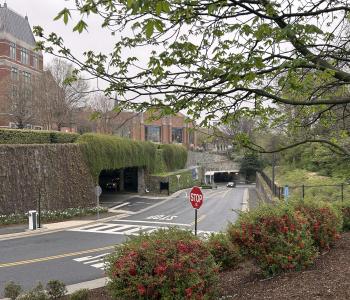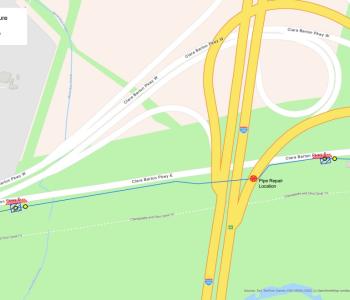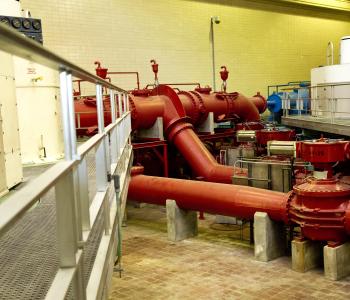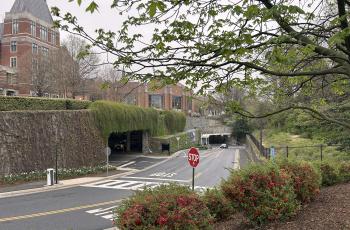DC WASA and National Park Service Break Ground on Operation Clean Air
Relief is on the way from odors along the C&O Canal due to the 50-mile long Potomac Interceptor sewer. The District of Columbia Water and Sewer Authority (DC WASA) and the National Park Service (NPS) broke ground today on the first of six odor-scrubbing facilities that will remove the vents that have for years emitted sewer gases to the open air above.
Getting to this point has taken time and effort, but its wonderful to stand here today with a permanent solution underway that benefits everyone, said DC WASA General Manager George S. Hawkins. We can all be proud of the end result, which is attributed to the passion and commitment of the people assembled here today.
We have been working with DC WASA for a permanent fix to the odors and are pleased with this solution that will control odors, provide new public restrooms and will blend in with the park surroundings, said National Park Service Superintendent Kevin Brandt.
The groundbreaking was held at Fletchers Boathouse, the site of the first scrubbing facility to be built and the only one located in the District. The facility features a new set of public restrooms to make the park more enjoyable for visitors. DC WASA and NPS also plan three scrubbing facilities in Montgomery County, Maryland; Loudoun County, Virginia and Fairfax County, Virginia, at a total cost of approximately $14 million.
The Potomac Interceptor (PI) sewer was constructed in the 1960s by the Federal government to connect Washington Dulles International Airport and several suburban jurisdictions to the Blue Plains Advanced Wastewater Treatment Plant. Shortly thereafter, complaints surfaced about the odor coming through the vents, especially along the picturesque C&O Canal, a favorite destination for outdoor enthusiasts.
Todays groundbreaking comes more than 10 years after DC WASA began work to contain the odors. After studying the problem and proposed solutions, DC WASA opted to build scrubbing facilities that would remove all but a few of the vents along the 50-mile sewer. The work will control odors and preserve the sewer line from the corrosiveness of the gases. The remaining vents are necessary to create the vacuum effect that keeps the sewage flowing in this gravity-fed sewer. Until the buildings are complete, DC WASA will continue to use measures such as gel neutralizer pots and chemical additions.
The District and Maryland facilities are under construction, due to be completed in late 2011. DC WASA is still securing permits for the two Virginia sites, anticipating completion of construction in early 2012.
More information about the project can be found at: http://www.dcwasa.com/workzones/projects/potomac_interceptor.cfm
###
About The District of Columbia Water and Sewer Authority
The District of Columbia Water and Sewer Authority (DC WASA), is an industry leading multi-jurisdictional regional utility that provides drinking water, wastewater collection and treatment to nearly 600,000 residential, commercial and governmental customers and 16 million annual visitors in the District of Columbia, and also collects and treats wastewater for 1.6 million customers in Montgomery and Prince Georges counties in Maryland and Fairfax and Loudoun counties in Virginia.
DC WASAs service area covers approximately 725 square miles and the company operates the worlds largest advanced wastewater treatment plant with a capacity of 370 million gallons per day and has a peak capacity of 1.076 billion gallons per day.
About the Chesapeake and Ohio National Historical Park
The C&O Canal, as it is more affectionately known to locals, is this nations best example of what and how commercial trade operated in this country in the 1800s and early 1900s. The 184.5-mile Canal runs from Cumberland, Maryland to Georgetown, in Washington, D.C. and attracts nearly four million annual visitors who are able to learn first-hand how life and commerce existed for over 100 years. The C&O Canal also provides multiple recreational and educational possibilities, including hiking, biking, canoeing, kayaking, and boating as well as locations such as the Great Falls Tavern Visitor Center in Potomac, MD, the Cushwa Basin Visitor Center in Williamsport, MD and the Cumberland Visitor Center in Cumberland, MD for education and interpretive programs. The late U.S. Supreme Court Justice William O. Douglas made famous the Canal and changed the editorial policy of The Washington Post with his 1953 and 1954 walks along the entire length of the Canal.







